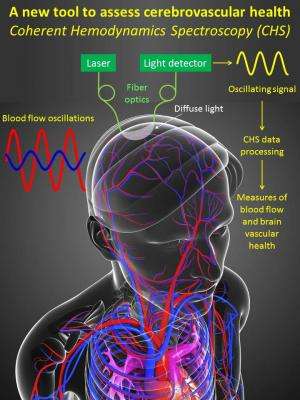A new way to diagnose brain damage from concussions, strokes and dementia

New optical diagnostic technology developed at Tufts University School of Engineering promises new ways to identify and monitor brain damage resulting from traumatic injury, stroke or vascular dementia—in real time and without invasive procedures.
Coherent hemodynamics spectroscopy (CHS), developed and published by Tufts Professor of Biomedical Engineering Sergio Fantini, measures blood flow, blood volume, and oxygen consumption in the brain. It uses non-invasive near infrared (NIR) light technology to scan brain tissue, and then applies mathematical algorithms to interpret that information.
"CHS is based on measurements of brain hemodynamics that are interpreted according to unique algorithms that generate measures of cerebral blood flow, blood volume and oxygen consumption," says Fantini. "This technique can be used not only to assess brain diseases but also to study the blood flow and how it is regulated in the healthy brain."
Tufts has licensed CHS on a non-exclusive basis to ISS, a Champaign, Ill.-based company that specializes in technology to measure hemoglobin concentration and oxygenation in brain and muscle tissue.
"Potentially the market for CHS is large as it encompasses several applications from the monitoring of cerebrovascular disorders to assessing neurological disorders," says Beniamino Barbieri, president of ISS. "It reminds me of the introduction of ultrasound technology at beginning of the seventies; nobody back then knew how to utilize the new technology and of course, nowadays, its applications are ubiquitous in any medical center."
How It Works
CHS uses laser diodes which emit NIR light that is delivered to the scalp by fiber optics. Light waves are absorbed by the blood vessels in the brain. Remaining light is reflected back to sensors, resulting in optical signals that oscillate with time as a result of the heartbeat, respiration, or other sources of variations in the blood pressure.
By analyzing the light signals with algorithms developed for this purpose, Fantini's model is able to evaluate blood flow and the way the brain regulates it—which is one marker for brain health.
CHS technology has been tested among patients undergoing hemodialysis at Tufts Medical Center. Published research reported a lower cerebral blood flow in dialysis patients compared with healthy patients.
"Non-invasive ways to measure local changes in cerebral blood flow, particularly during periods of stress such as hemodialysis, surgeries, and in the setting of stroke, could have major implications for maintaining healthy brain function," says Daniel Weiner, M.D., a nephrologist at Tufts Medical Center (Tufts MC) and associate professor of medicine at Tufts University School of Medicine (TUSM), who is a member of the research team.
Josh Kornbluth, M.D., a neurologist at Tufts MC and associate professor of medicine at TUSM, is also working with Fantini to explore CHS's potential to assess the cerebrovascular state of patients who suffer traumatic brain injury or stroke. They hope to test CHS further among neurological critical care patients.
"Having data about local cerebral blood flow and whether it is properly regulated can allow us to more accurately develop individualized therapy and interventions instead of choosing a 'one size fits all' approach to traumatic brain injury, stroke, or subarachnoid hemorrhage," Kornbluth says.


















